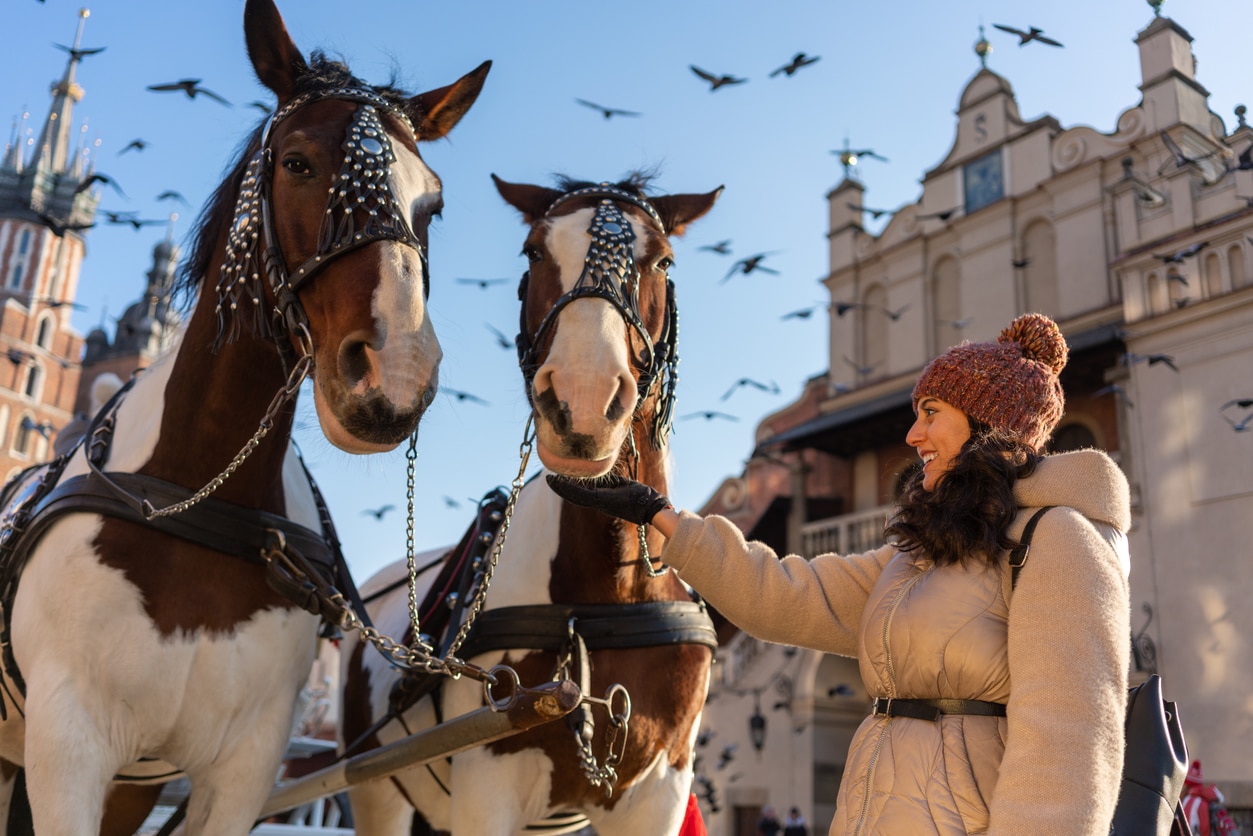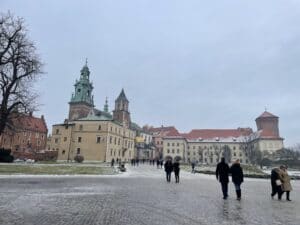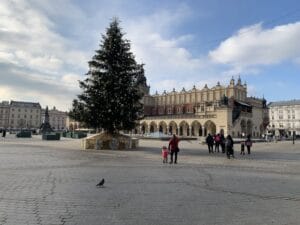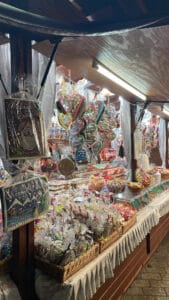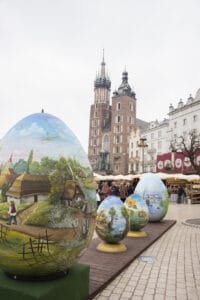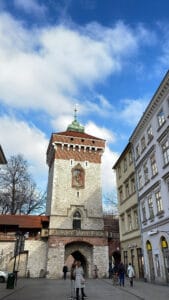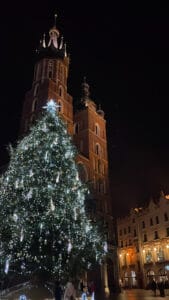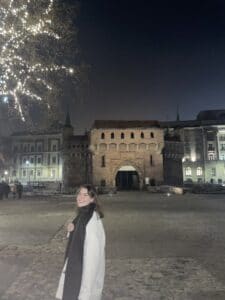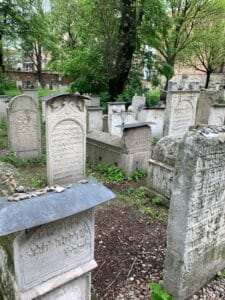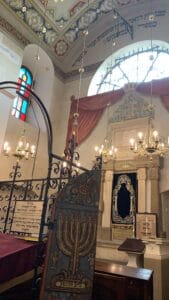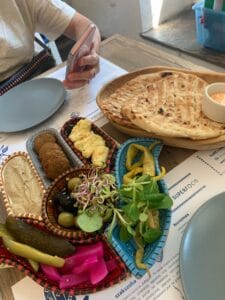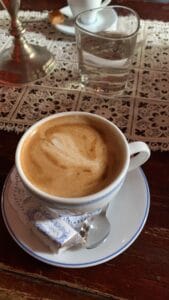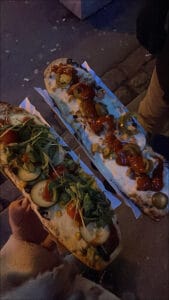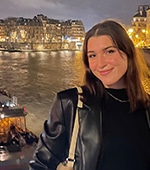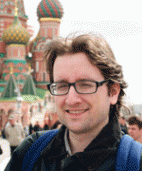Kraków is Poland’s most visited city and is known as the county’s cultural capital. Krakow’s old town was one of the first UNESCO World Heritage Sites, is a UNESCO City of Literature, and offers amazing architecture, history, and food. Just 2.5-3 hours from Warsaw, you take in many of the major sites in three days for just 650 PLN ($160) or less – including transportation, accommodation, food, and attractions.
The rich cultural heritage in Kraków makes it the perfect weekend destination from Warsaw and a must for anyone studying abroad in Warsaw who wants to gain a broader understanding of Poland and its culture.
History of Kraków
Founded in the seventh century, Krakow was a busy trading settlement by the mid 10th century. It was invaded and destroyed by the Mongols in the 1200s, but was rebuilt almost stone-for-stone to what it was before. Many of its famous sites today date back to this time of reconstruction.
A former Polish capital, Krakow remained the cultural and intellectual center of Poland after the seat of government moved to Warsaw in 1596. Kraków also evaded some of the worst incursions on Poland, retaining independence as the Free City of Kraków during the partitions of Poland, and coming out of World War II with relatively little damage to its architecture, unlike the other major cities of Warsaw, Poznań, Wrocław, and Gdańsk.
Founded in the seventh century, Krakow was a busy trading settlement by the mid 10th century. It was invaded and destroyed by the Mongols in the 1200s, but was rebuilt almost stone-for-stone to what it was before. Many of its famous sites today date back to this time of reconstruction.
A former Polish capital, Krakow remained the cultural and intellectual center of Poland after the seat of government moved to Warsaw in 1596. Kraków also evaded some of the worst incursions on Poland, retaining independence as the Free City of Kraków during the partitions of Poland, and coming out of World War II with relatively little damage to its architecture, unlike the other major cities of Warsaw, Poznań, Wrocław, and Gdańsk.
There are also several other very good reasons why Krakow is a cultural capital. It is home to Jagiellonian University, one of Europe’s oldest universities, established in 1364. The city has a vibrant academic community, attracting scholars, researchers, and students from around the world. Krakow hosts numerous festivals and events throughout the year such as the Krakow Festival, which includes music, dance, theater, and film events. Krakow has been a significant center for art and literature for centuries.
Krakow has been the birthplace or residence of many renowned Polish artists, writers, and intellectuals. This includes sci-fi writer Stanislaw Lem, who now has a “Garden of Experiences” where one can learn the laws of nature by experiencing them directly through “110 devices demonstrating phenomena from an array of fields, including mechanics, optics, hydrostatics, magnetism, and acoustics, … gathered on a space of around 6 ha (15 acres).” It includes Wislawa Szymborska whose flowing, witty poetry can be heard yearly read as part of Krakow’s annual Poetry Knights Festival, when poetry floods the many coffee houses and public spaces in the city. It also includes Jan Matejko, Poland’s celebrated “national painter” whose former home is now a house museum and who has a major square named for him.
These are just a few of the numerous cultural institutions ranging from theaters, galleries, and music venues that make Krakow such a vibrant cultural city!
Logistics
Getting to Krakow from Warsaw on Poland’s PKP train takes around 2.5-3 hours. It will cost from 65 to 120 PLN ($17-30) with the 50% discount offered to students. You’ll also find that many attractions have student discounts as well, so always look for them. You can buy tickets ahead of time online and save them either on your phone or print them out for a smooth trip.
Kraków’s main train station is located right in the center of the city, a 10-minute walk from the Main Square. You will also find many budget and student-friendly hostels in this area. The cost of a dormitory bed in a hostel can range from 30 to 100 PLN per person per night, depending on the location, amenities, and time of year. I recommend the Dizzy Daisy Downtown Hostel or the Greg and Tom Hostel. A bed at either will average 35-70 PLN ($9-18) per night, so you shouldn’t have to pay more than 40 dollars for accommodations for the weekend. Hostelworld.com is a great website to find a hostel that fits your needs. If you are looking for more space and privacy, there are some pretty cheap Airbnb options in Kraków as well — on my recent trip, I stayed in an apartment a 5-minute walk from the Main Square for about 40 dollars a night!
Another easy place to cut costs is food – A meal at an inexpensive restaurant can cost around 20-40 PLN per person. If you choose to eat at local fast-food chains or grab snacks from local bakeries or markets, you can still try many local delicacies and reduce your expenses further. This said, Krakow also has a vibrant food scene and treating yourself to a least one full dinner is highly recommended!
Day 1: Arrive and Fill Your Belly
Upon arrival in Kraków, one of the best ways to familiarize yourself with your surroundings is to just go on a walk around the Old Town. This is what I did on my last trip there, acting as a tour guide for a friend I had brought who had never visited before. I grew up visiting Kraków every other summer to visit my grandparents and extended family and became very familiar with the city and its culture. I also got to act as a translator on this trip, since I am bilingual in Polish and English, and my friend doesn’t speak even a bit of Polish.
We arrived late in the evening, tired but starving, so we walked to the Rynek Glowny (Main Square) to grab a bite to eat.
We were visiting just after Christmas, so the Main Square was bustling with Christmas market vendors selling kiełbasa, soup, naleśniki (Polish-style crepes), baked goods, and oscypki (smoked cheese from the Tatra mountains, usually served with cranberry sauce). During the summer, the Main Square is also the location for many festivals and events and often has late-night food options.
The side streets shooting out from the square in each direction have many dining options like BaniaLuka, a restaurant and bar located on Szewska street where you can get a drink for 5 złoty and a traditional Polish entree of pierogi, herring, or soup for 10 złoty ($2.50). It gets pretty crowded and rowdy on weekends, when it stays open until 6 in the morning.
If you are looking for a classier option with still affordable dishes, there is a popular restaurant called Morskie Oko in the area, which serves traditional Polish dishes in a Góral (Polish highlander) themed dining room. The restaurant combines an appreciation for the culture of the Tatra mountain people and delicious Polish food. Since Kraków is the closest big city to the Tatras, you can find little bits of Tatra culture everywhere.
Day 2: Castles, Cathedrals, Tombs, and Towers
With only a couple of days in Kraków, you probably want to get to exploring pretty early in the morning. So, try one of these options for a great, fast breakfast and coffee before you head out.
- Żarówka Cafe serves amazing coffee but also Kraków-style bagel sandwiches with veggies, cheese, cold cuts, or even Nutella. The bagels, called obwarzanki Krakowskie, are braided ring-shaped breads topped with poppy seeds, salt, or sesame seeds. They are specific to Kraków and are actually geographically protected by the EU, so they can’t be produced anywhere outside the Kraków region! Definitely try them while you are here!
- Lajkonik Cafe is a chain that serves very affordable coffee, pastries, and sandwiches – perfect for a quick breakfast or takeaway coffee!
After breakfast, head to the Wawel Royal Castle and get there before it gets busy. For a true experience, take Kraków’s Royal Road to get there. It passes Kraków’s most famous landmarks and was used for royal processions when Kraków was the capital.
Starting at the north end of the Old Town, head from the Barbican — a 15th century fortified outpost that historically served as a gateway into the city — toward St. Florian’s Church. The Royal Road takes you down Floriańska Street, one of Krakow’s most famous streets, to the Rynek Główny (Main Square). You will return to the Main Square later, but to get to the Wawel, take Grodzka Street from the square. Walking down Grodzka street you will pass many churches, including the Church of St. Adalbert, the Church of St. Francis of Assisi, which houses an exact replica of the Shroud of Turin, and the Church of Saints Peter and Paul, the first Baroque church in Poland. Grodzka Street ends at the foot of Wawel Hill, and just a 5-minute climb will get you to the castle.
Taking in the interiors of the Wawel will take 1-2 hours depending on the exhibition. I opted for a self-guided tour of the Wawel staterooms, which included a temporary art exhibition. With the student discount, tickets are 20 PLN ($5).
During the high season in the summer, you can also climb into the “Dragon’s Den.” According to a local legend, this cave was home to the Wawel Dragon, who tormented Krakow’s population until a peasant named Krak lured the dragon into eating a lamb stuffed with sulfur, which exploded inside the dragon and killed it. Kraków’s name supposedly originates from Krak, the savior of the village who then became king.
Also on Wawel Hill is the 12th-century Wawel Cathedral and Tombs. Tickets are ordinarily 22 PLN, but 15 PLN for students, and touring the cathedral and its royal tombs takes around 30-45 minutes. Poland’s monarchs as well as some national heroes and important figures are buried here — among them war heroes Jozef Pilsudski and Tadeusz Kosciuszko, poet Adam Mickiewicz, and, controversially, former President Lech Kaczynski and his wife, who were killed in a plane crash in 2010. The room where Kaczynski is buried was surprisingly, or maybe not, the most crowded and had the highest security.
After visiting the Wawel, spend your afternoon hours exploring the Old Town in the daylight. Walk along the Planty, a scenic Kraków city park that encircles the Old Town. In the summer, it is full of greenery and a popular picnic spot, and in the winter, it is often blanketed with snow. Until the 19th century, this is where Kraków’s Medieval city walls stood, and you can still see remnants of the wall at St. Florian’s gate and the Barbican.
There are three main landmarks in the Main Square.
One free attraction is The Cloth Hall (known locally as Sukiennice), which was the center of Kraków’s booming textile trade in the 16th century. Construction of the hall began in the 14th century, replacing an earlier market structure. As the center of a commercial hub, the Cloth Hall attracted merchants from all over Europe who came here to trade primarily textiles but also spices and other goods on the main floor. The upper floors served as a gathering place for social events, feasts, and official ceremonies. They also housed art studios, attracting renowned painters and sculptors and served as a venue for exhibitions and auctions.
The Cloth Hall largely retains these functions today. On the first floor, you can find anything and everything Kraków and Poland-related, from t-shirts to folk costumes. Several stalls also specialize in things like leather goods or amber jewelry. While souvenirs from Sukiennice might be overpriced compared to souvenirs you can buy outside of the main square, they are still relatively cheap and you can truly find everything here.
Another landmark at Main Square is the Ratusz Tower, the only remaining part of the 14th century Kraków town hall which was burned down in 1820. Today you can go to the top of the tower and get a great view of the Old Town.
The final landmark to take in is St. Mary’s Basilica. Made up of two towers, it was built in the 13th century and is most famous for its altarpiece carved by sculptor Veit Stoss. You can visit the basilica for just 5 złoty, and if visiting in the summer, you can add on a ticket to climb to the top of the taller tower for 15 złoty. Make sure to stick around the area until the top of the hour. This is when a trumpet signal called the Hejnał Mariacki is played from the top of the tower on all four sides. Interestingly, the tune is cut off in the middle very suddenly, to commemorate a legendary trumpeter who was shot by Mongols attacking the city while sounding the alarm.
When you are looking to refuel during the day, consider one or both of these options:
- Polish Kiełbasa (Kielbaski z Niebieskiej Nyski) is Kraków’s original food truck. It’s a blue communist-era Nysa van from which two men serve grilled kielbasa every night until 2 in the morning. Locals know it as the best kielbasa in town (even my grandma stood in line once to try the famed sausage), but it is popular with tourists as well. The van is a 10-15 minute walk from the main square located in the Hala Targowa outdoor market, but it is definitely worth the extra walk.
- Chimera is a restaurant and salad bar with tons of vegetarian and vegan options. They serve meat as well, but a self-service Polish restaurant with so many vegetarian options is pretty hard to find, so this one deserves a shoutout. You pay based on how many items you get on your plate, and a full plate of 6 items is about 21 PLN ($5.50). The interior of the restaurant is beautiful – it feels like you’re stepping into a greenhouse with all of the plants and sunlight flowing in.
Day 3: The Kazimierz Jewish Quarter
Kazimierz is Krakow’s Jewish quarter and is definitely worth a day to visit. Once its own city, Kazimierz was connected to Kraków’s Old Town in the 19th century and is only a 15-minute walk from the Main Square.
For most of its history, Kazimierz was a place where Polish Catholics and Jews coexisted peacefully. Some 65,000 Jews lived in Kraków before World War II. Shockingly, only about 140 Jews remain in Kraków today. However, Jewish history remains strong here and the city is making efforts to revive Jewish culture.
Today, you’ll find many Jewish restaurants serving kosher food, a Jewish bookstore, and even a festival of Jewish culture that takes place every June in Kazimierz. The district is a mixture of contemporary life and interesting history, with trendy coffee shops and vintage stores nestled right next to some of the oldest synagogues in Poland.
Start on the corner of Miodowa Street and Szeroka Street, near the Remah Synagogue, one of only two active synagogues in Kraków. A 5 złoty ticket allows you to tour its interiors as well as the cemetery, which is one of the oldest Jewish cemeteries in all of Poland. It was almost completely destroyed during World War II, but parts of it were restored, and fragments of tombstones that couldn’t be restored were used to build a wailing wall outside the synagogue.
Now continue down Szeroka Street, to a small square that was the center of Jewish life here. At the end of the square is the Old Synagogue, which dates back to the 15th century and now houses a museum of Jewish culture and history in Kraków.
From here, I recommend just walking through the many little streets of Kazimierz and exploring different shops, cafes, and sites.
Kazimierz has some of the best restaurants and cafes in Kraków. Here are some that I recommend.
-
- Hamsa serves modern Israeli food with many vegan and gluten-free options. When I went, I split a mezze plate with one other person and got to choose from 3 mezzes which come with pita bread, olives, and pickled vegetables. We got hummus, falafel, and fried sheep’s cheese. All of this was around 50 PLN and was a great snack but not enough for a big meal.
- Mleczarnia is a cafe with a beautiful, antique-style interior. The walls are covered with photographs of Jews and Christians who lived in the Kazimierz before the war. Stop in for a coffee in the morning, and then come back at night for a drink. The cafe also serves breakfast and small plates all day if you’re hungry. Mleczarnia is always busy with local students camping out to do work, meet a friend, or just to take in the atmosphere.
- Plac Nowy is not a restaurant, but translates to “New Square” in English. In the middle there is a rotunda with different food stalls. This is a great place to try zapiekanki, popular across Poland, which are essentially pizzas on a baguette, served with cheese, mushrooms, and your choice of toppings and sauce (although ketchup is traditional). You can also find good kebab here, another very common Polish street food. The best part is that you get an incredibly filling meal for 10-15 PLN.
- Judah Square is where to head for food trucks. There are many different foods you can try here, including sausages, burgers, Belgian-style fries, loaded baked potatoes, coffee, etc., but one I would like to highlight is the Andrus food truck, which specializes in a Cracovian pulled pork sandwich called maczanka Krakowska. And yes, “Cracovian” is the proper adjective to use to refer to something from Krakow.
In the afternoon, you can either stay in the Kazimierz or head back to the Old Town to visit a museum.
Oskar Schindler’s Enamel Factory is recommended. Created after Schindler’s story was made popular after Steven Spielberg filmed Schindler’s List in Kraków, it now houses an exhibition about Kraków under Nazi occupation. Tickets are 24 PLN ($6) for students.
For art lovers, try Princes Czartoryski Museum on Pijarska Street in Old Town. The museum contains Polish artworks, antiques, and military artifacts, but the main highlight is a Leonardo da Vinci painting on permanent exhibition, called Lady with an Ermine. The museum is usually pretty quiet and this painting is by itself in a dark room, allowing you to have an incredibly intimate experience with a famous piece of art that you wouldn’t be able to get at a museum like the Louvre. This museum also houses a Rembrandt painting, Landscape with the Good Samaritan, that is worth checking out. Tickets are 25 PLN ($6) for students.
Conclusion: Go To Krakow!
If you have a free weekend, Kraków is an essential visit in Poland that is easily doable in a few days. Of course, it is impossible to see everything in Kraków in three days, but the city is compact and walkable, so you can take in a lot of culture and history in a short time. Once an overlooked European destination, Kraków has become very popular in recent years, and for good reason. Its affordability, beautiful architecture and history, and trendy food scene make it the perfect weekend destination.
Originally published Feb 1, 2022. Updated by SRAS staff on July 3, 2023.

